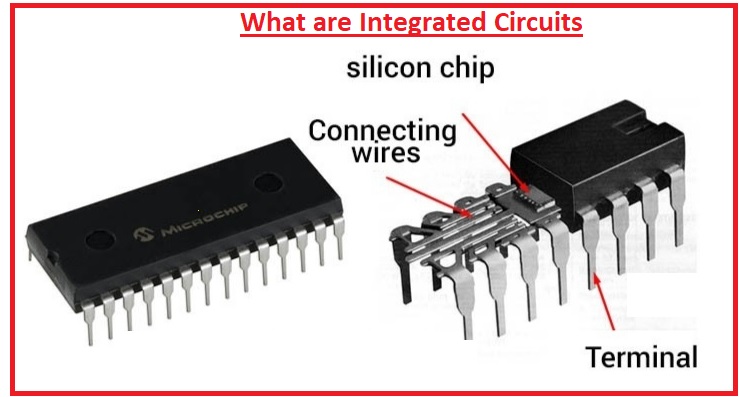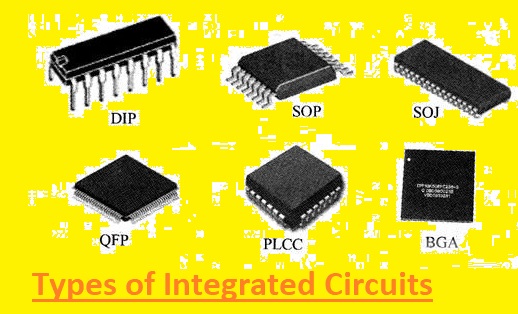Hello readers welcome to the new post. Here we will learn What are Integrated Circuits. There are different changes made in the field of electronics due to the use of integrated circuits. Since it helps tp make small devices used in different projects and components. In this post, we will discuss different parts for integrated and electrical components. In this post, we will cover IC circuits, working, and their different types uses, and applications. Let get started with What are Integrated Circuits
Introduction to Integrated Circuits
What are Integrated Circuits
Integrated circuits, also known as microchips or ICs, are small-size electronic circuits created on small components of semiconductor materials, normally made of silicon. Transistors, capacitors, resistors, and diodes are commonly used electronics that come with integrated circuits. There are different technique used to configure these components in semiconductor material.
Importance of Integrated Circuits
Integrated circuits are considered as basic components of electronic. Now they are the main part of different devices and projects due to their small sizes, good operation, and less power use such small mobile phone computers are made with ICs. They are considered as important for different field of life due to their innovative design and layout
Types of Integrated Circuits
Analog Integrated Circuits
There a different types of continuous signals such as temperature, sound, and voltage, which are processed by analog integrated circuits. They are made with accurate amplification and vary accurately. Analog Ics are used in audio amplifiers, sensors, power magne systems
Digital Integrated Circuits
Discrete signals are processed with digital ICs with the use of binary digits (bits), which are two conditions zero or one. These circuits carry differnt logic operations such as arithmetic computations, data storage, and control actions. Computers, calculators, and digital signal processors operated on digital integrated circuits.
Mixed-Signal Integrated Circuits
Analog and digital circuitry are linked to make one single chip that are mixed-signal integrated circuit. They offer effective conversion and processing of signals by helping simple integration of analog and digital functions. Communication circuits, automobiles based electronic and date-gathering systems commonly have mixed-signal integrated circuits.
Uses of Integrated Circuits
- Wristwatches
- Radar
- Computers
- Juice makers
- Televisions
- decoders and encoders
- Microwave amplifiers
- Logic devices
- Video processors
- Memory devices
- Audio amplifiers
- Radiofrequency
- Voltage regulators
- Small-signal amplifiers
Functioning of Integrated Circuits
Fabrication Process
Differnt processes are used to make integrated circuits such as design, etching, lithography, doping, and packaging. Circuits design are made by engineers with the use of computer-aided design (CAD) software, that’s then employed in photolithography to make silicon wafers. good electrical components and interconnections, the wafer passes in the chemical and physical processes.
Components of Integrated Circuits
Resistors, Transistors, capacitors, and diodes are some main components if ICs. Transistors are considered as a building block to the main functions such as amplification and switching.
Capacitor stores charges diode converts ac to dc and resists used to restrict current flow
What Is Resistor? – Symbols, Types and Its Applications
Transistor Symbols | Definition, Terminals & Operating Condition
What is a Capacitor Polarity – Construction, Its Types, Function & Applications
Introduction to Diode, Pinout, Working, Features & Applications
ICs Advantages and Disadvantages
| Feature | Advantages | Disadvantages |
|---|---|---|
| Size | Extremely small and lightweight | |
| Power consumption | Low power consumption | Requires specialized equipment and skills for repair or replacement |
| Reliability | Highly reliable | Can be prone to failure |
| Cost | Cost-effective to produce | Expensive to design and produce |
| Performance | Provides high levels of functionality and performance | Can be subject to obsolescence |
| Versatility | Can be used in a wide range of applications | Can be vulnerable to electromagnetic interference |
| Durability | Resistant to physical damage | |
| Ease of replacement | Easy to replace |
Future Trends in Integrated Circuits
Miniaturization and Nanotechnology
Nanotechnology use and comes with miniaturization of integrated circuits are mauin features. Engineers are finding different techniques to make compact and effective parts, enabling high integration and good operation
Internet of Things (IoT)
The main factors in creation of IoT are integrated circuits. They helps to make different devices such as opening the door for connected systems that enhances productivity and easiness like smart homes and industrial automation.
Microcontrollers
A CPU, memory, and input/output devices are configured with controllers that are type of flexible integrated circuits. Embedded system that operates smart devices, industrial control system and vehicles based electronic based on these cricuts.
Operational Amplifiers (Op-Amps)
Analogue integrated circuits also called operational amplifiers are used in signal conditioning and amplification. They are important audio instrument, medical devices and sensor interfaces since thy have high value of gain and accuracy for amplifying analog signals. In different applications, op-amps assist analog signals are reliable and high-quality.
Field-Programmable Gate Arrays (FPGAs)
Programmable integrated circuits also known as FPGAs comes with adaptable and programmable digital logic features.. They are made with different routing channels connecting programmable logic block arrays. Digital circuits are frequently prototyped, fastly created and comes in small quantitieswith use of FPGAs. They employed in industries such as high-performance computing, aircraft, and telecommunications.
Digital Signal Processors (DSPs)
Special types of ICs called digital signal processors are made for effectively processing digital signals. Filtering, modulation, and compression of digital data are currently fast-growing. DSPs are used in different telecommunication networks, audio, and video processing system
Memory Chips
Memory chips, that stores and retrieve data are the main parts of modern devices, mobile phones, computer, and other digital devices used in different types of memory chips, for example, Dynamic Random Access Memory (DRAM), Static Random Access Memory (SRAM), and Flash memory. Memory chips offer fast data storage and help easy data access.
Power Management ICs
power control for management and regulating the power distribution in an electronic system, integrated circuits are needed. They do different operations such as voltage management, power conversion, and battery charging. Smartphones, electric cars, laptops, and renewable energy systems based on power management ICs. Their battery increases provide effective efficiency and protect devices from power-related problems.
Digital-to-Analog Converters and Analog-to-Digital Converters
Integral circuits convert analog and digital signals, such as ADCs and DACs. ADCs transform analog signals from the real world, such as sound or temperature, into digital data for processing, DACs do that operation in reverse form. To offer accurate signal transformation, these circuits are important for measuring tools, and audio systems.
Conclusion
Electronic devices that are small in size, strong, and effective are made due to the use of ICs. They come in different types such as analog, digital, and mixed-signal circuits, and each comes with its own uses and features. telecommunications, the automobile, and medical devices use these circuits.
FAQS
What is ICs in the circuit?
- The integrated circuit is an assembly configuration of electronic components where hundreds to millions of resistors, transistors and capacitors are connected on a thin substrate made of semiconductor material to make small chips or wafers.
What are ICs used for?
- Computers and Laptops:
- Smartphones and Tablets:
- Televisions and Home Appliances:
- Automotive Systems:
- Medical Equipment:
- Communication Systems:
- Industrial Control Systems:
What is IC types of ICs?
- Logic gates:
- Memory chips:
- Microprocessors:
- Amplifiers:
- Filters:.
- Oscillators:
- RF circuits:
What are the three types of ICs?
- Digital ICs:
- Analog ICs:
- Mixed-Signal ICs:
What are the 2 basic types of IC?
- Analog ICs:
- Digital ICs:
Here is a table that summarizes the key differences between analog and digital ICs:
| Feature | Analog IC | Digital IC |
|---|---|---|
| Signal type | Continuous | Binary (1 or 0) |
| Applications | Amplifiers, filters, oscillators | Logic gates, memory, processors |
| Examples | Operational amplifier, voltage regulator | Logic gate, memory chip, microprocessor |
What is the symbol for IC?
The integrated IC is shown by a rectangular box with pins
Which IC is most commonly used?
The commonly used integrated circus is logic gates. Logic gates are building blocks of digital circuits. They do basic logical operations such as AND, OR, and NOT. Logic gates come in electronic devices, computers, mobiles, and appliances.
Here are some examples of logic gates:
- AND gate: An AND gate produces a logic 1 output only if both of its inputs are logic 1.
- OR gate: An OR gate produces a logic 1 output if either of its inputs is logic 1.
- NOT gate: A NOT gate produces a logic 1 output if its input is logic 0, and vice versa
Which is a popular type of IC?
The most popular type of IC is the memory chip. memory chips used for data strong in computers and other devices. They come in different types and sizes, such as static random-access memory (SRAM) dynamic random-access memory (DRAM), and read-only memory (ROM).
Is IC digital or analog?
ICs can be either digital or analog.
- Digital ICs: it work on binary zero and one signal. They are used as memory, logic gates, and processors.
- Analog ICs: it operate on continuous analog signals. It is used in amplifiers, filters, and oscillators.
What are the advantages of IC?
- Small size:
- Low cost:
- High reliability:
- High performance:









1 Comment